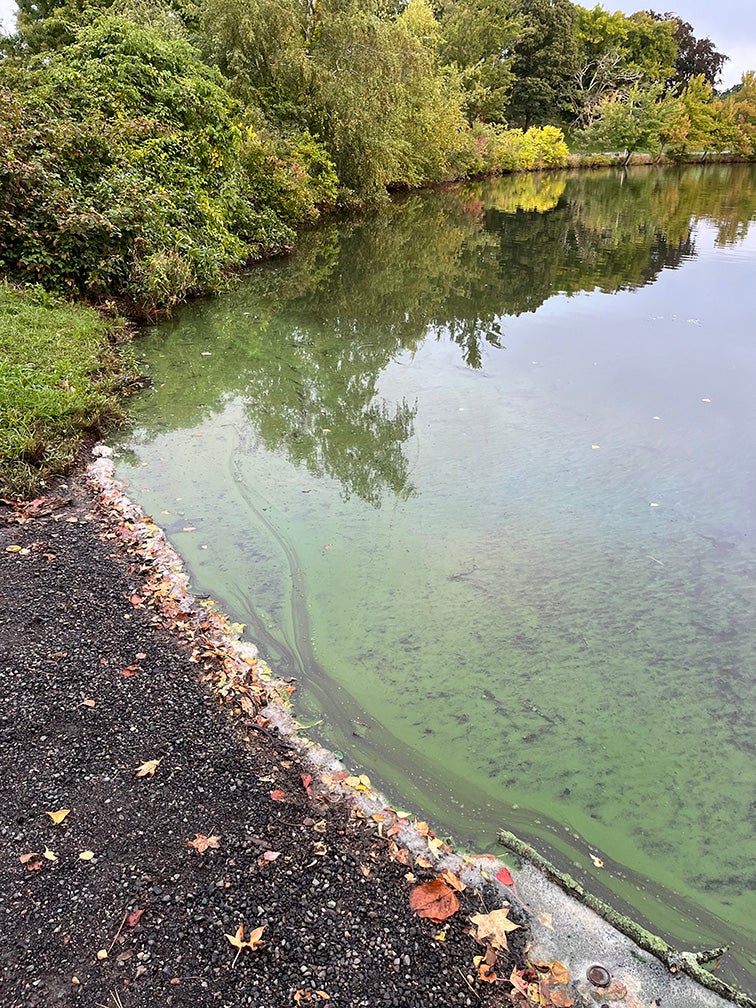How toxic is green slime?
By Patrick Luce
Bacterial algal blooms and the toxins they produce are a persistent problem in freshwater lakes and rivers and have affected local populations by contaminating drinking water and placing a significant burden on local economies due to diminished recreational activity. The toxins can sicken pets and livestock that drink directly from the waterways, and potentially pose a significant danger to people’s health.
University of Rhode Island College of Pharmacy Professor Matthew
Bertin is trying to mitigate the problem, discovering new toxins in local
waterways and working to develop a detection and monitoring system to protect
the public, thanks to a $400,000 research grant from the National Institute of
Environment Health Sciences, a division of the National Institutes of Health.
Bertin and his team of three pharmacy graduate students are scouring three lakes in Roger Williams Park in Providence — Pleasure Lake, Polo Lake and Cunliff Lake — harvesting algae when it blooms on the surface and testing it for toxins.
The team is also working with biotech firm Biosortia Pharmaceuticals Inc., which has the capacity to access and harvest unprecedented amounts of algae to study. Biosortia’s harvesting technologies enable researchers to evaluate aquatic microbial chemistry in its most natural state. While its work just began in September, the team is already showing results, uncovering a surprising, and potentially alarming, number of new toxins.
“Just doing some cursory work, we found five new toxins. We think there are likely dozens,” Bertin said. “The Biosortia team led a study with help from my lab and found some exquisitely toxic molecules; we called them cyanobufalins. They’re crazy toxic. One of the great challenges is that some highly potent toxins are difficult to access. Our lab, working with Biosortia, has found previously undetected elusive toxins. We really think there are many new toxins in these blooms that haven’t been characterized yet. We’re trying to understand the full spectrum of toxins in these bloom events. Are we missing certain toxins that we need to be monitoring?”
The most prevalent danger of the toxins to people is the effect
they can have on the liver. When the bacteria find their way into freshwater
drinking systems and are ingested, they can infiltrate the liver, causing
damage and possibly liver failure. The toxins can also cause skin ailments when
people are exposed to the water, and can also potentially be ingested through
dietary supplements like Spirulina, made from bacteria.
Bertin and his team collect water from the lakes in the park once
a week, or when conditions are right for an algae bloom, which seem to be most
common in late summer and early fall, indicating water temperature may play a
role. They filter the water through various size filters to extract different
organisms for study. As the team discovers new toxins, they are categorized so
they can be monitored in fresh waterways going forward, and alerts can be
issued when there is a danger.
“Many organisms are in there. We are trying to tease apart the
community members (bacterial organisms) and connect them to particular toxins,”
Bertin said. “We want to find out which toxins are created by which critters.”
Studying algae is nothing new for Bertin, who has worked for years
on the blooms in both fresh and salt water. His previous work has discovered
potentially beneficial chemicals in the blooms that can be key to reducing
neuroinflammation, a primary factor in diseases such as Alzheimer’s and
Parkinson’s.
Fresh water algae are particularly concerning, however, due to
their proximity to people and the potential to deliver harmful toxins into the
water supply. Bertin’s study, “Shifting paradigms to emerging toxins in
freshwater cyanobacterial blooms,” is funded for the next two years, during
which the team plans to discover and categorize the full community of toxic
bacteria found in algal blooms, and document the effects those toxins have on
the human body.
“What we’re really going for is trying to provide new knowledge on
the full breadth of these toxins,” Bertin said. “We want to know what the toxic
microcystins are, how to detect them and how to monitor them. We also want to
know how these toxins work together. Do they all combine for a bigger dose? Do
they act separately inside your body on different systems? We are trying to
understand the full breadth of the human impact these blooms might have,
especially as they become more common, due to how humans manipulate the land
and water resources, and a warming climate.”
